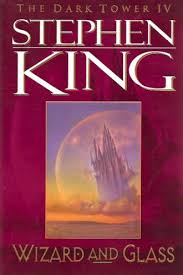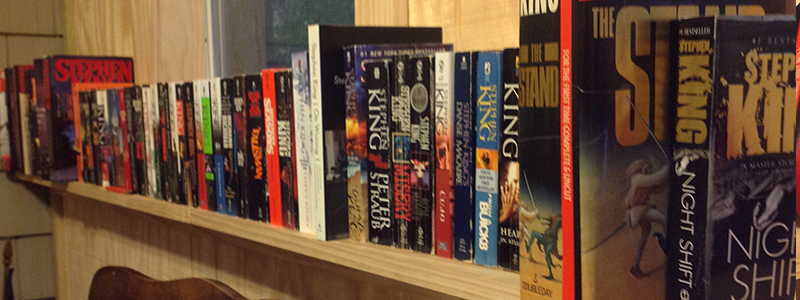by Jay Wilburn
The plan is to reread all of Stephen King’s works in the order that they were published. Richard Chizmar of Cemetery Dance had the vision. I’m doing it because I am a writer and I want to improve my fiction. And I love Stephen King’s stories. I think there is something to be learned through this process.
You can also go back to the beginning and read Before Carrie or any of my other posts up through this one and beyond by checking out this link to the Master List of all my #StephenKingRevisited posts.

In the back of Wizard and Glass, book IV in The Dark Tower series, Stephen King talks about writing one 16 hour time period in the Mid World storyline. He started the first half of that story in the 70s and finished the second half 26 years later. I started reading this book in 1997, stalled on the story, and finished rereading it from beginning to end just now 23 years later. I know this because I found three college theater tickets to the school I graduated from in 1996. My girlfriend, who would become my wife, was in the play and I went up to see her pretty much every weekend. I had one ticket each for the November 21st, 22nd, and 23rd shows (Friday through Sunday) in 1997. Then, I used the tickets as bookmarks in my first failed attempt to read through this novel.
Apparently, Julie and Marsha handle Stephen King’s mail and most of what he got were requests to continue The Dark Tower series. And we return to Blaine the Mono on a suicide run with our old katet of friends trying to save themselves through a game of riddles. The race toward death with Blaine may be one of my favorite moments in the entire series.
If you ever wondered how President Reagan would handle the super flu in a slightly different world from our own, a thin spot in reality in Mid World, now maybe End World, shows us. It is much like our world, but with a few different brands of cars, restaurants, and sodas. Our world made it through the 80s, but as Jake points out, the plague of the Dark Man can come to any world in devastating fashion. Maybe 2020 is our year.
A newspaper provides a glimpse into this devastated world they temporarily visit. Later, a stranger paper from a stranger place brings up more questions than answers. That paper has Vol. MDLXVIII No. 96 on it. That volume number would be 1568. I can’t find any significance to that number as a year or in terms of numerology by itself. It does seem to imply the place where the paper is found is at least that many years old and maybe older.
The old woman from their dreams living in Nebraska and the Dark Man are mentioned in a note by the unseen redemptive characters traveling west in a version of The Stand that took place in a different decade. Our characters pass by all this going another direction in that thin spot they need to escape.
Beware of the Walking Dude and the Crimson King the graffiti in a dead section of this world warns us.
The Charyou tree. Death for you; life for the crops. Reaping time. Time to burn the stuffies with their red hands and bodies packed with straw. You just know something bad is going to happen to everyone Roland loves before this story is over. True love is only interesting to those captured in it, King laments, and like any addictive drug, true love is dangerous. He admits in the notes at the end that writing the love story was daunting to him. I think it may be fair to say he did a better job with the love story this time than the climactic action.
We flashback through most of the novel to Roland’s youth shortly after becoming a gunslinger. On page 335, we get a brief interlude that winks back at the primary story of the series. On page 615 of 672, we come back to our original story and characters finally. But there are still some more flashback visions yet.
We open up in the heart of the story with the extended flashback in a mission to count things in a far-flung land, with a sinister meeting with a witch, with doomed encounters and doomed bargains, with welcoming parties containing too many layers of intrigue for our young characters to navigate, with dangerous young romance, and in a whorehouse standoff with Roland and his boys versus a failed gunslinger and his desperadoes. Then, the story becomes a long waiting game as each side tries to bait the other into making the first move. When the action does come, certain aspects of the violence go down far too easily which makes the wait seem almost pointless.
We are faced with great mysteries about two many horses in the land and an oil patch which seems far too close to our own world. The nature of this world before and after it moved on is a deep and twisted mythology. Technologies familiar to our world abound, but are ancient and forgotten to these people. Time moves differently in Roland’s world and the “thinny” stretches it.
In the author notes at the end, King talks about working on this novel or at least mentally preparing and committing to the work on the way back from Colorado, where he had finished up his part in the late 1990s mini series version of The Shining. He said he lost perspective around page 400. I went ahead and stuck my well preserved 1997 theater tickets back in the book on that page. King says he knows there are three more books in the series and talks as if he knows clearly what is to go in each one. He’ll end up writing those back to back after his van accident a little ways further down the timeline in our world.
This is not my favorite Stephen King novel for a variety of reasons, but I don’t hate it. It is growing on me more as I sit with it a while upon finishing it now.
There is a strong hint in this novel that the stories we create and the fairy tales we tell arise from other worlds where these things are real in their own forms. King through Roland tells us that “storytelling always changes time. At least it does in my world.”
My next post in this series will be Before Bag of Bones which will be linked on the Master List of all my Stephen King Revisited posts.





